Avoid exposing sensitive data by trusting "Server Notification" emails
Phishing/ScamAlso Known As: Server Notification spam
Get free scan and check if your device is infected.
Remove it nowTo use full-featured product, you have to purchase a license for Combo Cleaner. Seven days free trial available. Combo Cleaner is owned and operated by RCS LT, the parent company of PCRisk.com.
What is the "Server Notification" scam email?
"Server Notification" is a spam email campaign. The term "spam campaign" is used to define a large scale operation, during which scam emails are sent by the thousand.
There are several, practically identical variants of "Server Notification" emails. These messages claim that additional safety measures must be taken to secure recipients' email accounts. Note that "Server Notification" is a phishing spam campaign and extracts sensitive/private information from victims.
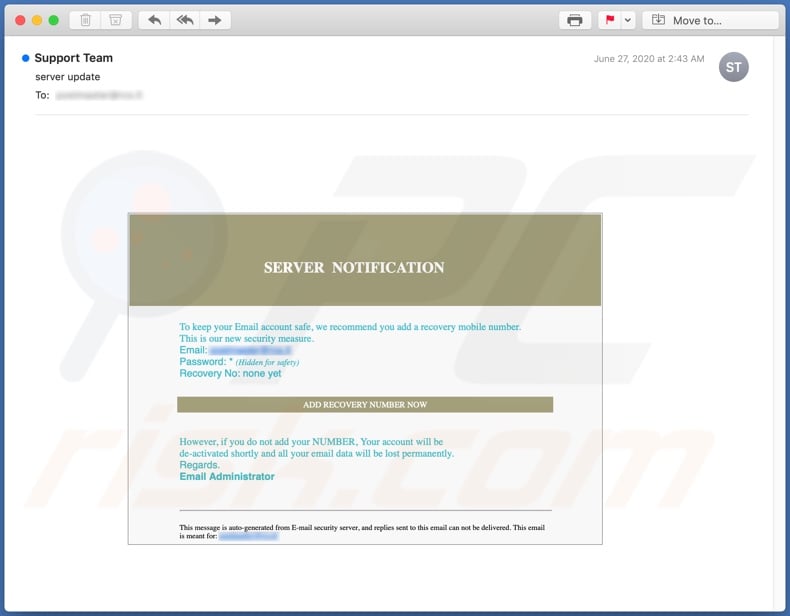
The researched "Server Notification" email variants are very similar, with a key difference being the reason given for the fake alert.
The messages state that, to keep the recipients' email accounts safe, they must provide a recovery mobile number. According to one variant, this is a new security measure, whilst another claims that a telephone number must be added due to irregular log-in attempts with an incorrect password having been observed to the email account in question.
The messages then go on to inform recipients that unless a mobile number is added, their email accounts will be suspended/deactivated and the email-related data, permanently lost. Typically, the links presented in such scam emails lead to phishing websites, which can target a wide variety of vulnerable information. Some steal account log-in credentials (i.e. usernames and passwords).
These sites are presented as generic sign-in pages or they can closely mimic ones of legitimate services (e.g. sign-in pages of genuine email service providers), however, phishing websites can also request other information such as names, addresses, telephone numbers, banking account and/or credit card details, etc.
These web pages can offer various fake reasons as to why the data must be entered, such as additional security measures, updates to contact or recovery information, billing information for subscription or other services, and so on.
To summarize, trusting "Server Notification" or similar emails can result in access loss to certain accounts, serious privacy issues, financial loss and even identity theft.
| Name | Server Notification Email Scam |
| Threat Type | Phishing, Scam, Social Engineering, Fraud. |
| Fake Claim | Additional safety measures are required to secure recipients' email accounts. |
| Disguise | Disguised as notifications from recipients' email administrator. |
| Related Domains | mcia[.]mu |
| Detection Names (mcia[.]mu) | Spamhaus (Phishing), Comodo Valkyrie Verdict (Phishing), CRDF (Malicious), DNS8 (Suspicious), Full List Of Detections (VirusTotal). |
| Serving IP Address (mcia[.]mu) | 197.227.37.5 |
| Symptoms | Unauthorized online purchases, changed online account passwords, identity theft, illegal access of the computer. |
| Distribution methods | Deceptive emails, rogue online pop-up ads, search engine poisoning techniques, misspelled domains. |
| Damage | Loss of sensitive private information, monetary loss, identity theft. |
| Malware Removal (Windows) |
To eliminate possible malware infections, scan your computer with legitimate antivirus software. Our security researchers recommend using Combo Cleaner. Download Combo CleanerTo use full-featured product, you have to purchase a license for Combo Cleaner. 7 days free trial available. Combo Cleaner is owned and operated by RCS LT, the parent company of PCRisk.com. |
"GitHub Email Scam", "Your Google Ads account has been suspended" and "ShareFile Attachment Email Scam" are some examples of other phishing spam campaigns. Deceptive emails are usually presented as "official", "urgent", "priority" and similar.
They can even be disguised as mail from legitimate entities (e.g. service providers, institutions, companies, etc.), however, phishing is not the only use of spam campaigns - they are also employed to proliferate Trojans, ransomware and other malware.
Regardless of what these scam messages claim, offer, request or demand, the purpose is the same: to generate profit for the scammers/cyber criminals behind them.
How do spam campaigns infect computers?
Systems are infected through dangerous files, distributed via spam campaigns. These files can be attached to the emails or, alternatively, the messages can contain download links of malicious content.
Infectious files can be in a wide variety of formats, such as Microsoft Office and PDF documents, archive (ZIP, RAR, etc.) and executable (.exe, .run, etc.) files, JavaScript, and so on. When malicious files are executed, run or otherwise opened, the infection process/chain is triggered.
I.e., once opened, the files initiate download/installation of malware. For example, Microsoft Office documents infect systems by executing malicious macro commands.
In MS Office versions released prior to 2010, the infection process begins when a dangerous document is opened, however, newer versions have "Protected View" mode, which prevents macros from being executed automatically.
Upon opening, users are asked to enable macro commands (i.e. to enable editing/content), and hence infection is only initiated if the macros are enabled manually.
How to avoid installation of malware
You are strongly advised against opening suspicious or irrelevant emails, especially those with any attachments or links present in them, as doing so can lead to high-risk system infection. You are advised to use Microsoft Office versions released after 2010.
As well as spam campaigns, malware is proliferated through dubious download channels (e.g. unofficial and free file-hosting websites, Peer-to-Peer sharing networks and other third party downloaders), illegal activation tools ("cracks") and fake updaters.
Therefore, only download from official/trustworthy sources and activate/update programs with tools or functions provided by legitimate developers. To protect device health and user safety, it is paramount to have a reputable anti-virus/anti-spyware suite installed.
This software must be kept updated, used to perform regular system scans and to remove detected threats/issues. If you have already opened malicious attachments, we recommend running a scan with Combo Cleaner Antivirus for Windows to automatically eliminate infiltrated malware.
Text presented in one variant of the "Server Notification" email message:
SERVER NOTIFICATION
To keep your Email account safe, we recommend you add a recovery mobile number.
This is our new security measure.
Email: -
Password: * (Hidden for safety)
Recovery No: none yet
ADD RECOVERY NUMBER NOW
However, if you do not add your NUMBER, Your account will be
de-activated shortly and all your email data will be lost permanently.
Regards.
Email Administrator
This message is auto-generated from E-mail security server, and replies sent to this email can not be delivered. This email is meant for: -
Another email from "Server Notification" spam campaign:
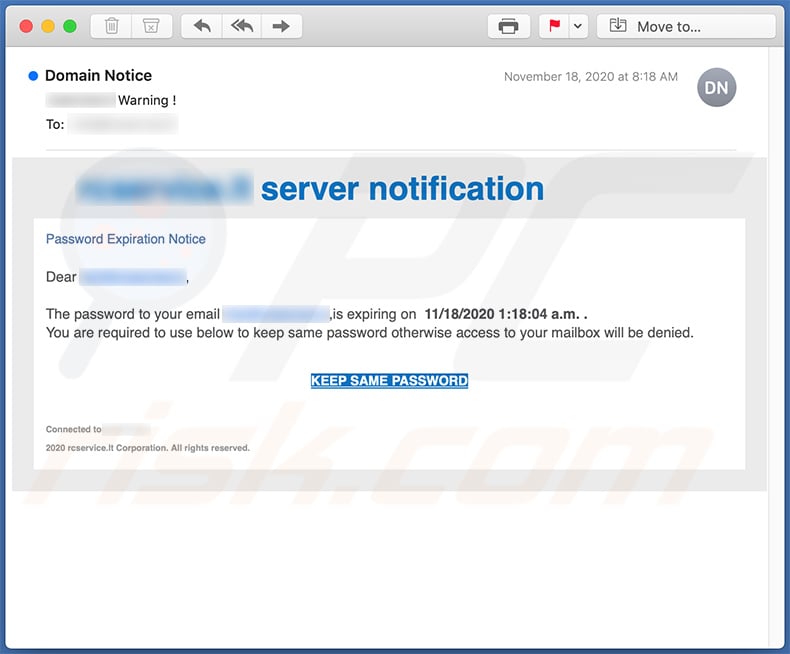
Text presented within:
Subject: ******** Warning !
******** server notificationPassword Expiration Notice
Dear ********,
The password to your email ********,is expiring on 11/18/2020 1:18:04 a.m. .
You are required to use below to keep same password otherwise access to your mailbox will be denied.KEEP SAME PASSWORD
Connected to ********
2020 ******** Corporation. All rights reserved.
Yet another similar spam email used to promote a phishing purposes:
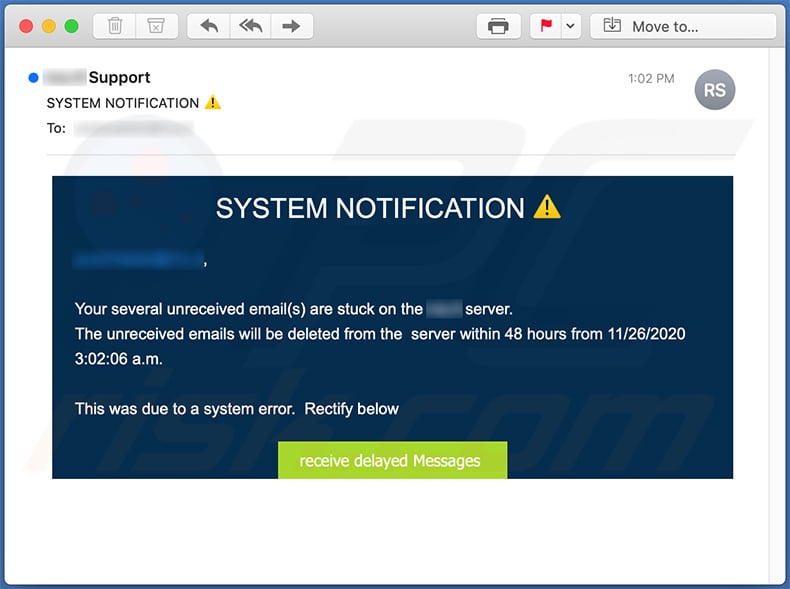
Text presented within:
Subject: SYSTEM NOTIFICATION
SYSTEM NOTIFICATION
********,
Your several unreceived email(s) are stuck on the - server.
The unreceived emails will be deleted from the server within 48 hours from 11/26/2020 3:02:06 a.m.This was due to a system error. Rectify below
receive delayed Messages
Yet another example of notification-themed spam email:
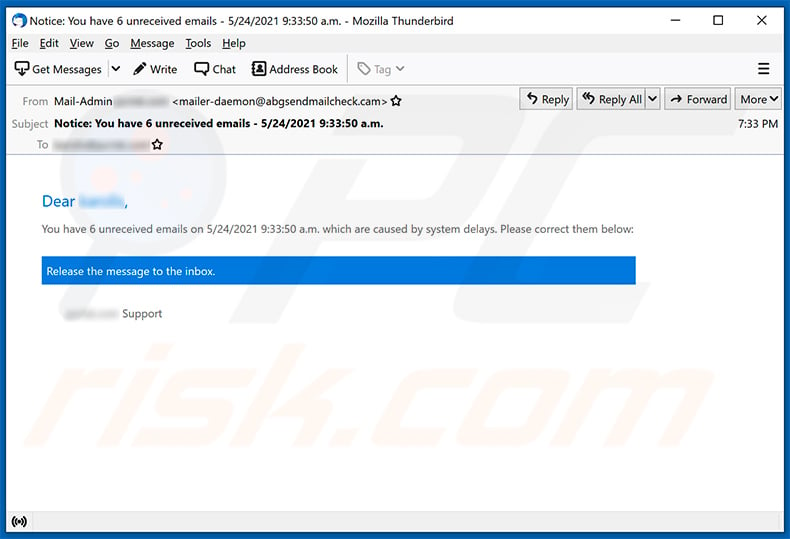
Text presented within:
Subject: Notice: You have 6 unreceived emails - 5/24/2021 9:33:50 a.m.
Dear ********,
You have 6 unreceived emails on 5/24/2021 9:33:50 a.m. which are caused by system delays. Please correct them below:Release the message to the inbox.
******** Support
Screenshot of the promoted phishing website:
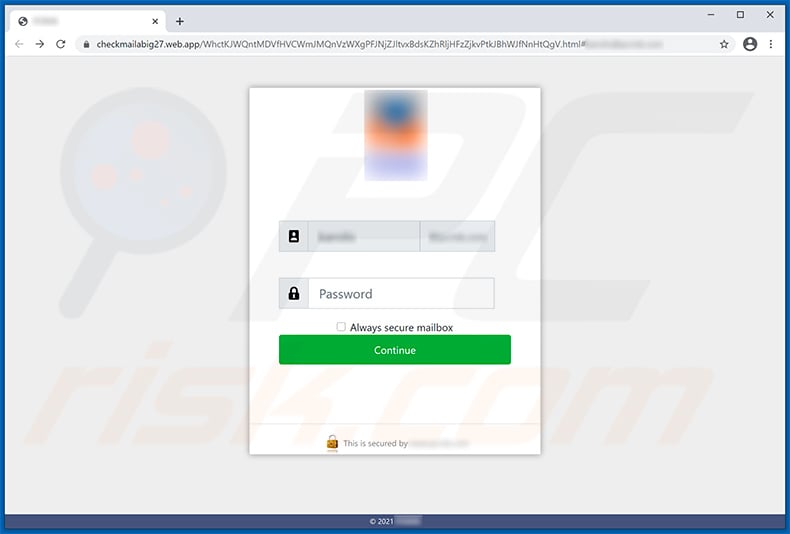
Yet another example of server notification-themed spam email:
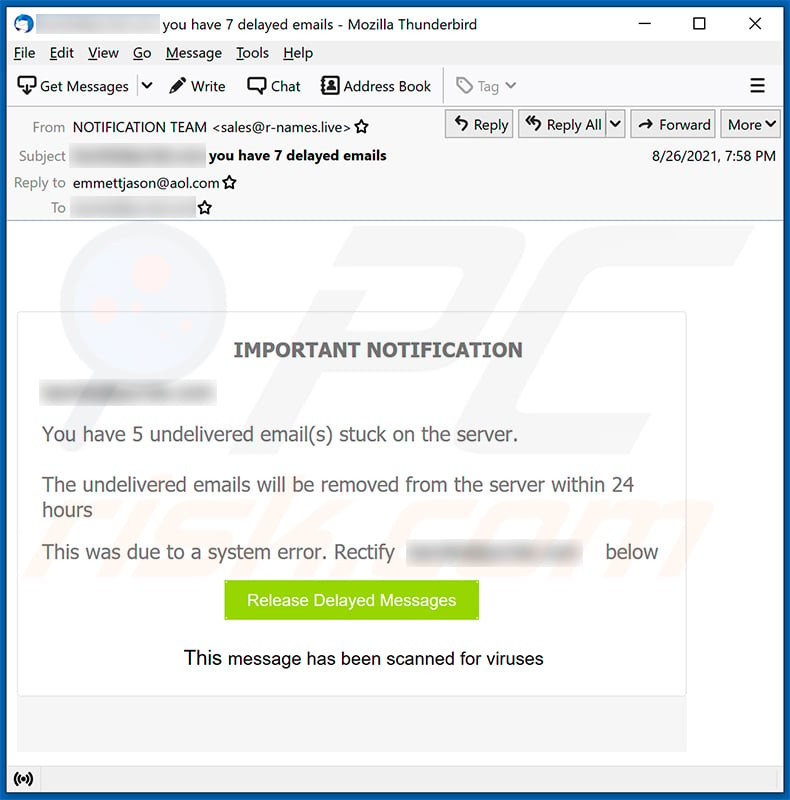
Text presented within:
Subject: ******** you have 7 delayed emails
IMPORTANT NOTIFICATION
********
You have 5 undelivered email(s) stuck on the server.
The undelivered emails will be removed from the server within 24 hours
This was due to a system error. Rectify ******** below
Release Delayed Messages
This message has been scanned for viruses
Yet another example of server error-themed spam email promoting a phishing site:
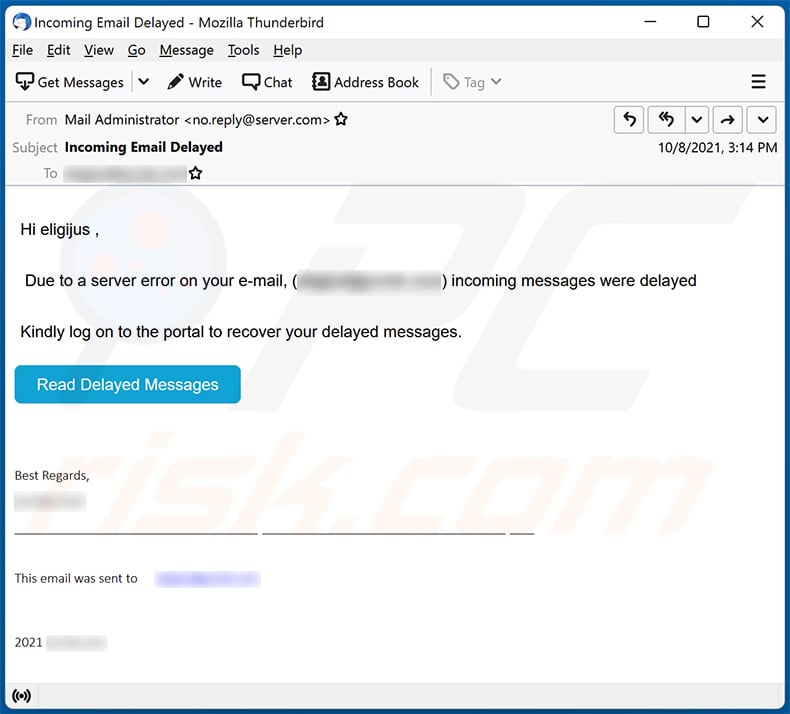
Text presented within:
Subject: Incoming Email Delayed
Hi - ,
Due to a server error on your e-mail, (********) incoming messages were delayed
Kindly log on to the portal to recover your delayed messages.
Read Delayed Messages
Best Regards,
********This email was sent to ********
2021 ********
Another example of server notification-themed spam email promoting a phishing site:
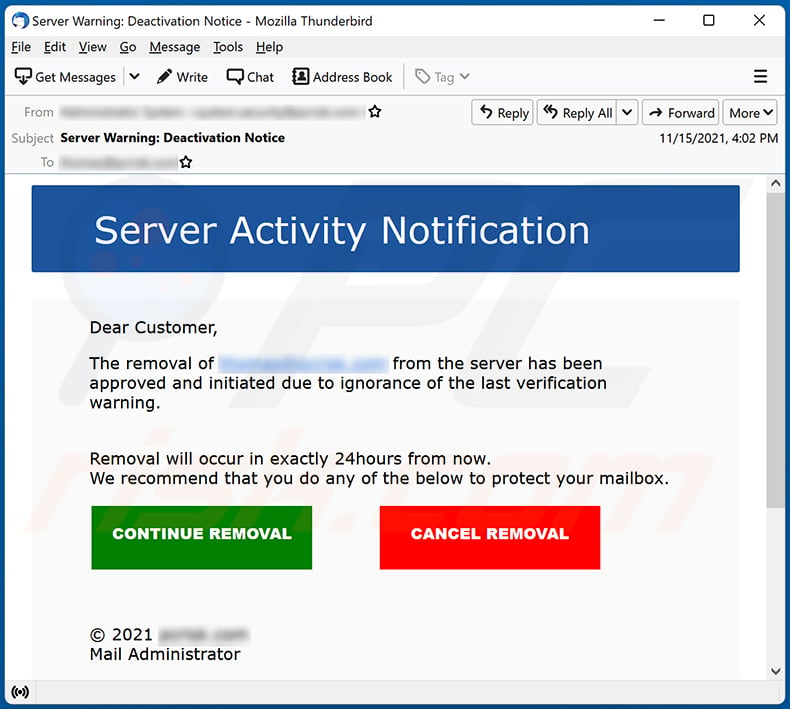
Text presented within:
Subject: Server Warning: Deactivation Notice
Server Activity Notification
Dear Customer,
The removal of - from the server has been approved and initiated due to ignorance of the last verification warning.
Removal will occur in exactly 24hours from now.
We recommend that you do any of the below to protect your mailbox.
CONTINUE REMOVAL
CANCEL REMOVAL© 2021 -
Mail Administrator
Screenshot of the promoted phishing site:
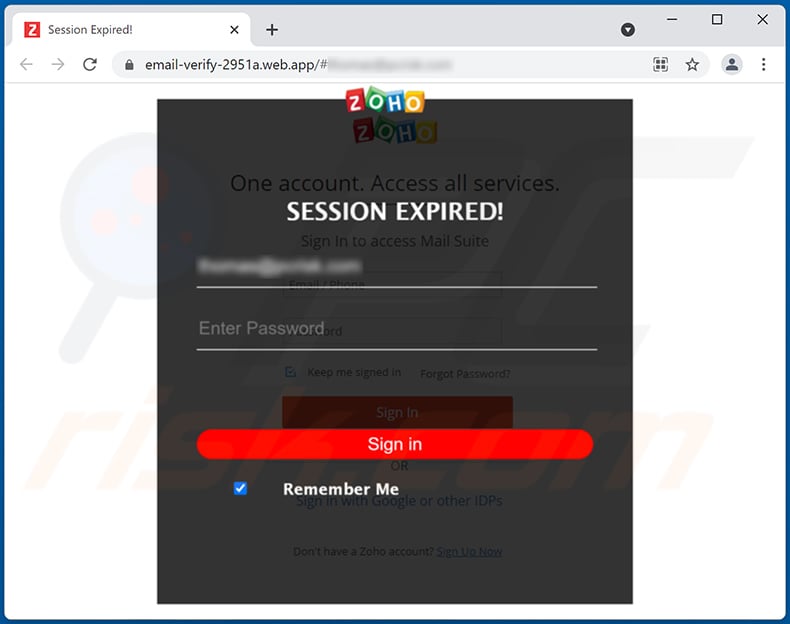
Yet another example of server notification-themed spam email promoting a phishing site:
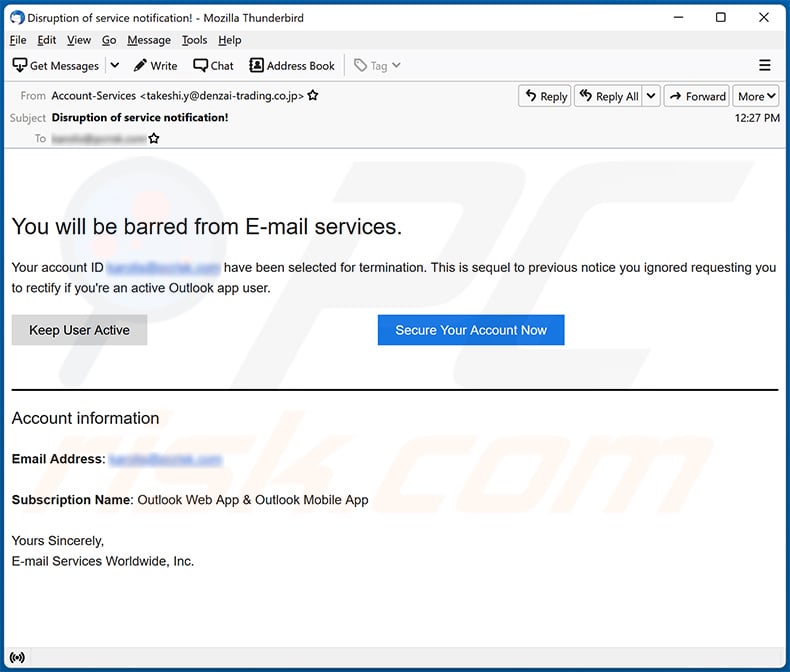
Text presented within:
Subject: Disruption of service notification!
You will be barred from E-mail services.Your account ID - have been selected for termination. This is sequel to previous notice you ignored requesting you to rectify if you're an active Outlook app user.
Keep User Active
Secure Your Account Now
Account informationEmail Address: -
Subscription Name: Outlook Web App & Outlook Mobile App
Yours Sincerely,
E-mail Services Worldwide, Inc.
Screenshot of the promoted phishing site:
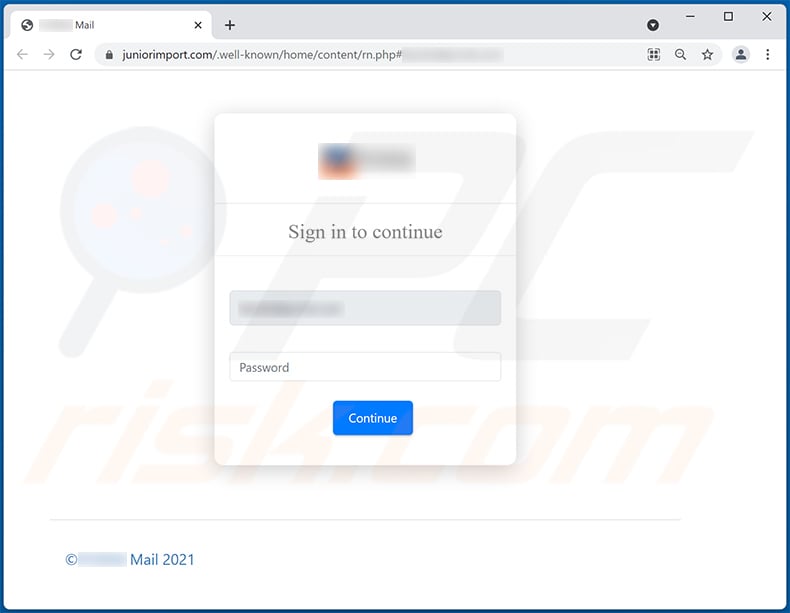
Another example of Server Notification-themed spam email promoting a phishing site:
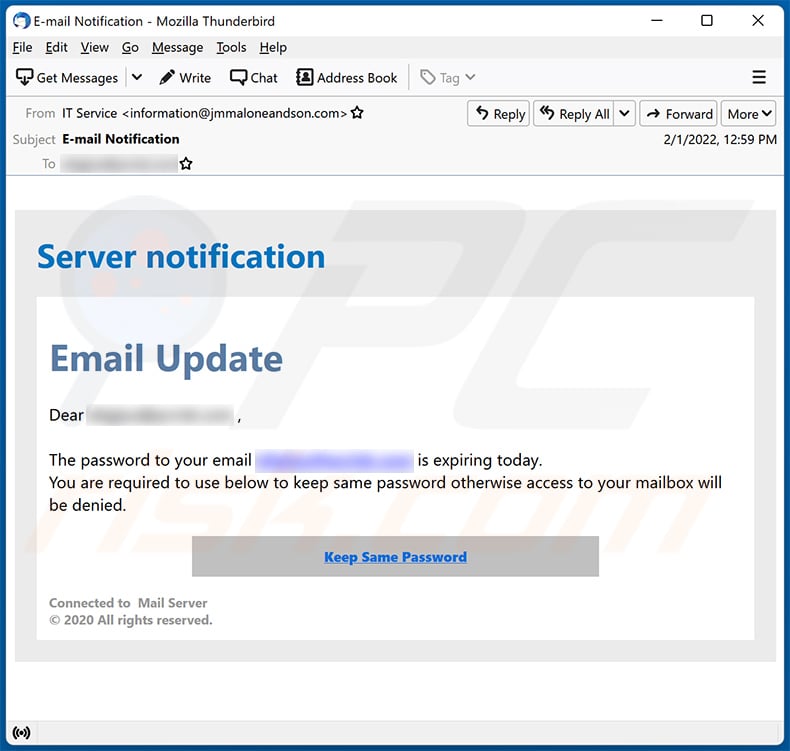
Text presented within:
Subject: E-mail Notification
Server notificationEmail Update
Dear - ,The password to your email - is expiring today.
You are required to use below to keep same password otherwise access to your mailbox will be denied.Keep Same Password
Connected to Mail Server
© 2020 All rights reserved.
Yet another example of Server Notification-themed spam email:
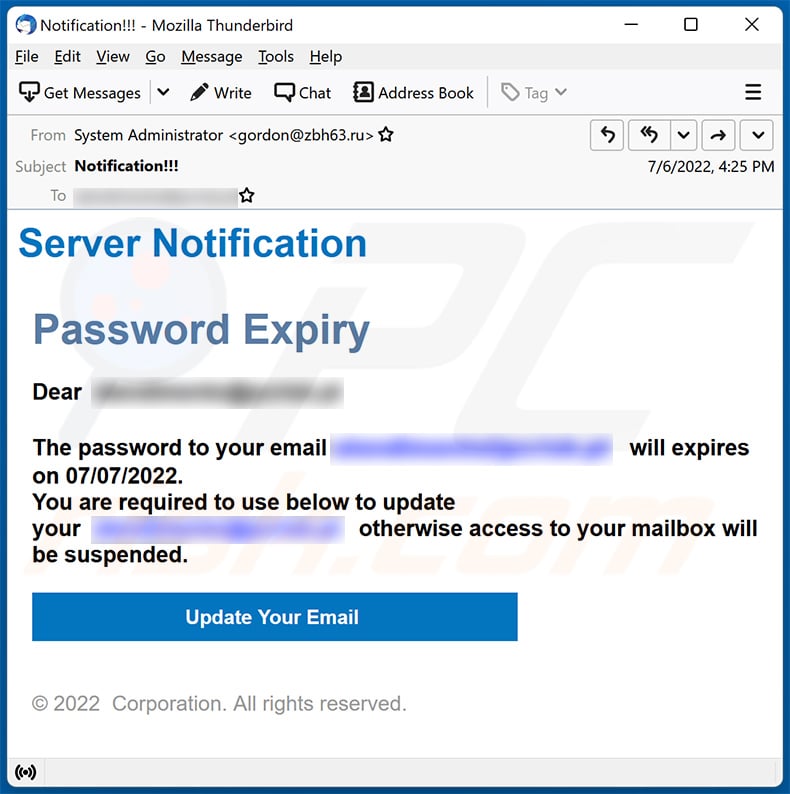
Text presented within:
Subject: Notification!!!
Server Notification
Password Expiry
Dear -The password to your email - will expires on 07/07/2022.
You are required to use below to update your - otherwise access to your mailbox will be suspended.
Update Your Email
© 2022 Corporation. All rights reserved.
Yet another example of server notification-themed spam email promoting a phishing site:
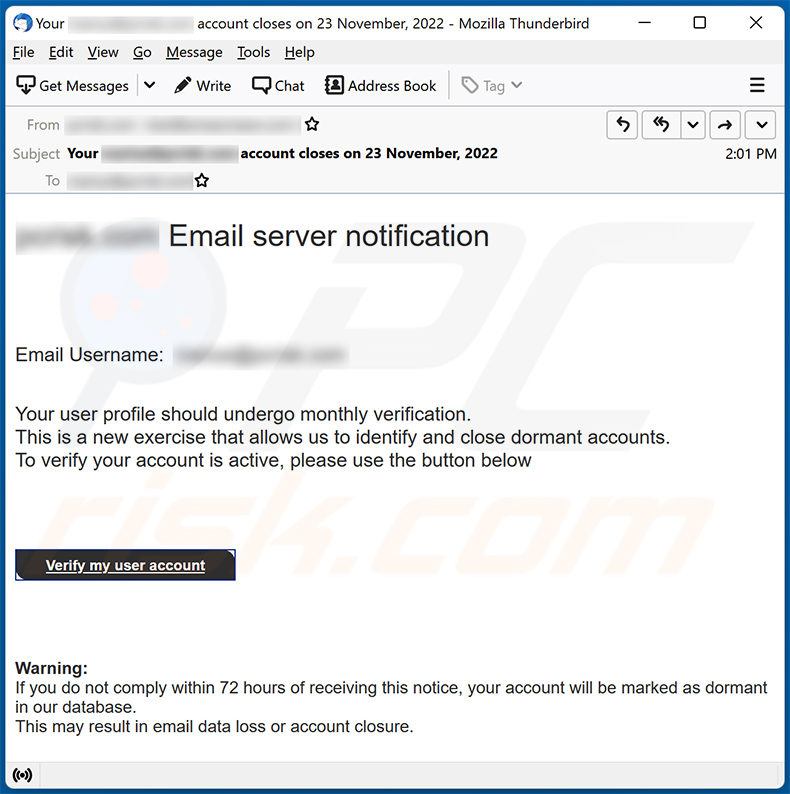
Text presented within:
Subject: Your ******** account closes on 23 November, 2022
******** Email server notification
Email Username: ********
Your user profile should undergo monthly verification.
This is a new exercise that allows us to identify and close dormant accounts.
To verify your account is active, please use the button belowVerify my user account
Warning:
If you do not comply within 72 hours of receiving this notice, your account will be marked as dormant in our database.
This may result in email data loss or account closure.
Screenshot of the promoted phishing site:
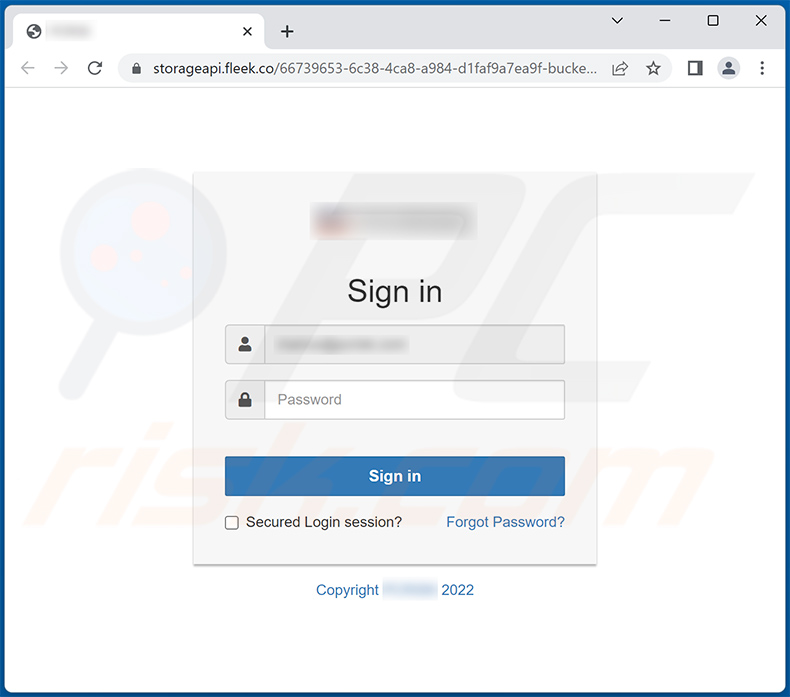
Instant automatic malware removal:
Manual threat removal might be a lengthy and complicated process that requires advanced IT skills. Combo Cleaner is a professional automatic malware removal tool that is recommended to get rid of malware. Download it by clicking the button below:
DOWNLOAD Combo CleanerBy downloading any software listed on this website you agree to our Privacy Policy and Terms of Use. To use full-featured product, you have to purchase a license for Combo Cleaner. 7 days free trial available. Combo Cleaner is owned and operated by RCS LT, the parent company of PCRisk.com.
Quick menu:
- What is Server Notification spam?
- Types of malicious emails.
- How to spot a malicious email?
- What to do if you fell for an email scam?
Types of malicious emails:
![]() Phishing Emails
Phishing Emails
Most commonly, cybercriminals use deceptive emails to trick Internet users into giving away their sensitive private information, for example, login information for various online services, email accounts, or online banking information.
Such attacks are called phishing. In a phishing attack, cybercriminals usually send an email message with some popular service logo (for example, Microsoft, DHL, Amazon, Netflix), create urgency (wrong shipping address, expired password, etc.), and place a link which they hope their potential victims will click on.
After clicking the link presented in such email message, victims are redirected to a fake website that looks identical or extremely similar to the original one. Victims are then asked to enter their password, credit card details, or some other information that gets stolen by cybercriminals.
![]() Emails with Malicious Attachments
Emails with Malicious Attachments
Another popular attack vector is email spam with malicious attachments that infect users' computers with malware. Malicious attachments usually carry trojans that are capable of stealing passwords, banking information, and other sensitive information.
In such attacks, cybercriminals' main goal is to trick their potential victims into opening an infected email attachment. To achieve this goal, email messages usually talk about recently received invoices, faxes, or voice messages.
If a potential victim falls for the lure and opens the attachment, their computers get infected, and cybercriminals can collect a lot of sensitive information.
While it's a more complicated method to steal personal information (spam filters and antivirus programs usually detect such attempts), if successful, cybercriminals can get a much wider array of data and can collect information for a long period of time.
![]() Sextortion Emails
Sextortion Emails
This is a type of phishing. In this case, users receive an email claiming that a cybercriminal could access the webcam of the potential victim and has a video recording of one's masturbation.
To get rid of the video, victims are asked to pay a ransom (usually using Bitcoin or another cryptocurrency). Nevertheless, all of these claims are false - users who receive such emails should ignore and delete them.
How to spot a malicious email?
While cyber criminals try to make their lure emails look trustworthy, here are some things that you should look for when trying to spot a phishing email:
- Check the sender's ("from") email address: Hover your mouse over the "from" address and check if it's legitimate. For example, if you received an email from Microsoft, be sure to check if the email address is @microsoft.com and not something suspicious like @m1crosoft.com, @microsfot.com, @account-security-noreply.com, etc.
- Check for generic greetings: If the greeting in the email is "Dear user", "Dear @youremail.com", "Dear valued customer", this should raise suspiciousness. Most commonly, companies call you by your name. Lack of this information could signal a phishing attempt.
- Check the links in the email: Hover your mouse over the link presented in the email, if the link that appears seems suspicious, don't click it. For example, if you received an email from Microsoft and the link in the email shows that it will go to firebasestorage.googleapis.com/v0... you shouldn't trust it. It's best not to click any links in the emails but to visit the company website that sent you the email in the first place.
- Don't blindly trust email attachments: Most commonly, legitimate companies will ask you to log in to their website and to view any documents there; if you received an email with an attachment, it's a good idea to scan it with an antivirus application. Infected email attachments are a common attack vector used by cybercriminals.
To minimise the risk of opening phishing and malicious emails we recommend using Combo Cleaner Antivirus for Windows.
Example of a spam email:

What to do if you fell for an email scam?
- If you clicked on a link in a phishing email and entered your password - be sure to change your password as soon as possible. Usually, cybercriminals collect stolen credentials and then sell them to other groups that use them for malicious purposes. If you change your password in a timely manner, there's a chance that criminals won't have enough time to do any damage.
- If you entered your credit card information - contact your bank as soon as possible and explain the situation. There's a good chance that you will need to cancel your compromised credit card and get a new one.
- If you see any signs of identity theft - you should immediately contact the Federal Trade Commission. This institution will collect information about your situation and create a personal recovery plan.
- If you opened a malicious attachment - your computer is probably infected, you should scan it with a reputable antivirus application. For this purpose, we recommend using Combo Cleaner Antivirus for Windows.
- Help other Internet users - report phishing emails to Anti-Phishing Working Group, FBI’s Internet Crime Complaint Center, National Fraud Information Center and U.S. Department of Justice.
Share:

Tomas Meskauskas
Expert security researcher, professional malware analyst
I am passionate about computer security and technology. I have an experience of over 10 years working in various companies related to computer technical issue solving and Internet security. I have been working as an author and editor for pcrisk.com since 2010. Follow me on Twitter and LinkedIn to stay informed about the latest online security threats.
PCrisk security portal is brought by a company RCS LT.
Joined forces of security researchers help educate computer users about the latest online security threats. More information about the company RCS LT.
Our malware removal guides are free. However, if you want to support us you can send us a donation.
DonatePCrisk security portal is brought by a company RCS LT.
Joined forces of security researchers help educate computer users about the latest online security threats. More information about the company RCS LT.
Our malware removal guides are free. However, if you want to support us you can send us a donation.
Donate
▼ Show Discussion